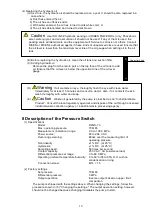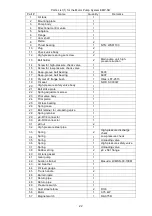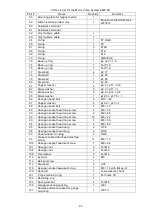
19
11 Troubleshooting
Condition
Cause
Remedy
The motor does not
rotate.
The electric outlet and power
plug is incorrectly connected:
the grounding wire, one of
the four wires of the power
cable, is mistakenly
connected to the power
source.
Turn off the power immediately to
avoid electric shock. Check whether
the connection is correct.
The electric outlet or power
plug is damaged.
An electric wire or operating
line is broken.
The start switch is damaged.
Using a tester, check whether a
proper voltage is observed at the
magnet switch and locate the fault.
According to the cause located,
replace the part(s) or retighten the
screws.
Terminal screws are loose or
the magnet switch has a
contact failure.
The motor circuit or
connected equipment is
improperly insulated.
With the power turned off, measure
the insulation levels of the primary
power source, motor, and connected
equipment (check that each measured
insulation level is 100 MΩ or higher at
500 mega V DC).
The overload relay has been
activated due to an
overcurrent caused by
continuous overload
operation, single-phase
wiring, or the operation with
voltage depression.
Locate the cause and take measures
against the fault. Then, press the
reset button of the over-load relay.
The pressure switch is
incorrectly set or damaged.
Check the setting for the pressure
switch. If it is correctly set, replace it.
The motor does not
rotate enough or
normally.
The voltage has dropped.
The voltage may drop during
pump operation even though
it is normal when the pump is
at rest.
This malfunction often occurs when
the cable between the power source
and the pump is long and thin.
Replace it with a thick cable. The
maximum allowable voltage
depression must be within 5% of the
rated voltage.
The motor rotates
without increasing the
pressure at all or
properly.
The motor rotates in the
incorrect direction.
When the motor rotates inversely, the
pump does not discharge oil.Reverse
the polarity of power supply so that
the motor will rotate correctly.
The hydraulic oil is
insufficient in amount.
Check the amount of the oil with the
oil level gauge. If it is not sufficient,
add oil.
Air is contained. When the
pump has been relocated or
hydraulic oil has been added,
it is possible that air has
entered the pump, disabling it
to increase the pressure.
With the lever of the directional
control valve set to the center, inch
the pump or let it rotate for a while.
The suction filter is clogged.
A clogged filter causes the
pump to produce noise and
discharge less oil.
Clean the suction filter and replace
the hydraulic oil.









































